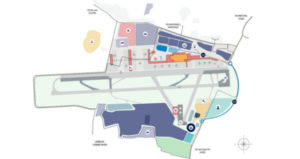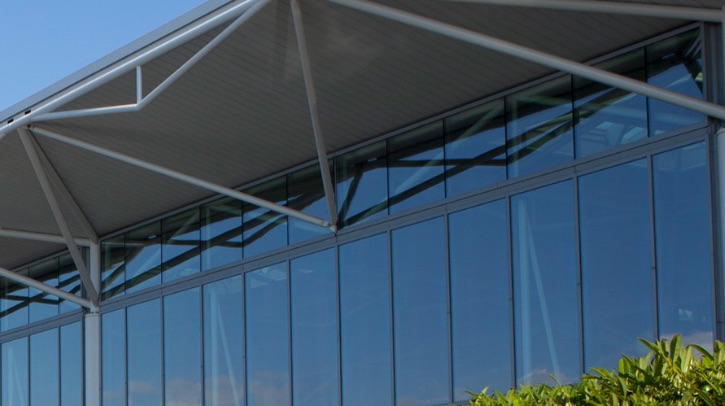Bristol Airport in the UK has launched a two-month consultation on its masterplan for 2040, which proposes a larger terminal building as well as connections to the US East Coast and the Middle East to meet meet future demand for air travel in the region.
Proposed changes

Alongside a larger terminal building, the proposals also include improved walkways directly serving aircraft to reduce passenger transport to aircraft by bus. To further improve the customer experience, travellators would be installed. Improved on-site facilities have also been included, such as retail, food and beverage and an additional hotel, as well as more space for flight catering, engineering and other requirements for airport businesses.
The airport has proposed new taxiways, apron extensions and additional aircraft stands, and a short runway improvement – around the size of one and a half football (soccer) pitches – that would enable longer-range aircraft, serving a limited number of long-haul destinations and more efficient short-haul flights that will continue to be the majority of flights for the foreseeable future. The runway improvement could help reduce noise from departing aircraft to the west.
Capacity improvements on the A38 road and improvements to public transportation connections to the airport have also been proposed. The masterplan also highlights plans to increase car parking provision to the north and south of the airport.
The consultation is intended to give people the opportunity to help shape the airport’s future. A dedicated website provides more information – including an interactive map – detailing proposals, which are also being shared with local residents this week. The consultation runs from November 25, 2024 to January 31, 2025.
Dave Lees, CEO of Bristol Airport, said, “We constantly look at trends in air travel and we’ve been pleasantly surprised that people want to continue to travel by air. We’ve seen since the pandemic a real resurgence in terms of people wanting to connect with friends and family across Europe as well as across the world and that will inform our plans as we go forward over the coming years. The masterplan will look at what further development might be required to meet this growing demand for air travel and we’d welcome input from people to help shape our plans.”
Increased connectivity
The proposals would enable the airport to provide more connections and serve new destinations, including a limited number of new longer-haul flights, connecting the region directly with destinations such as the East Coast of USA and the Middle East. The future development has been forecast to support more than 37,000 jobs in the Southwest and South Wales – including an additional 1,000 jobs at the airport, with employment focused on areas including Weston-super-Mare and South Bristol.
There are now more than 10 million passengers a year using Bristol Airport, providing more than 5,000 local jobs and contributing £2bn (US$2.5bn) to the regional economy. Connecting the region to more than 115 destinations increases productivity, supports businesses and enables inbound tourism.
The masterplan to 2040 will look at expected passenger growth beyond the current allowance of 12 million passengers per annum so it that can serve up to 15 million passengers per year by around 2036. This will set a clear development intent to be given due consideration in the local planning process, with a planning application likely to be sent to North Somerset council in 2026.
The increase in passengers from 12 million per annum to 15 million per annum would see aircraft movements increase from 85,990 to 100,000 per year in the longer term to meet demand for air travel. On a busy day in peak period, this would result in 35 extra aircraft movements. While night flying restrictions would remain, the airport is proposing to increase night flights by 1,000 – on average, four per night on a busy night in the peak period.
UK government policy supports the growth of airports outside the Southeast of England that make better use of existing runways, and that grow and develop new routes and services. Bristol Airport’s proposals to provide new destinations would reduce the journeys to London airports, which 10 million passengers make from the Southwest and South Wales every year.
Sustainability
Lees added that more than £400m (US$500m) is currently being invested on improving customer experience and reducing the airport’s carbon emissions. He said, “We’re continuously investing in improvements to meet current demand, with our new £64m (US$80m) Public Transport Interchange currently under construction. Work is also ongoing to decarbonize operations at the airport on projects removing gas from our site, to be replaced with heat pumps.
“We recognize there will be concerns about carbon emissions resulting from airport growth and the implications for climate change. So we are bringing forward proposals for what we consider to be responsible growth, growth that is both within the current UK carbon budgets required to meet net zero for all emissions by 2050, and with measures to achieve net-zero airport operations by 2030. Meanwhile, we are also committed to working with partners in our region on aviation decarbonization.”
Bristol Airport has worked closely with airlines to improve the type of aircraft operating from the airport. It has actively encouraged more quieter new engine option aircraft, which have a 50% reduction in noise compared to standard aircraft. One major airline has the highest number of quieter aircraft operating from Bristol Airport compared to its other UK bases.
In related news, earlier this year Bristol Airport invested £11.5m (US$14.6m) in next-generation security scanners, enabling all customers traveling through security to keep mobile phones, laptops and liquids in their hand luggage. Click here to read the full story.

